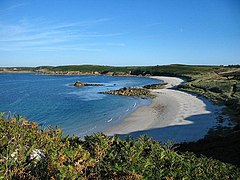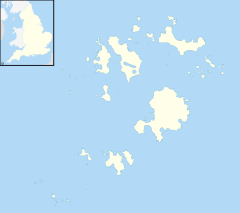St Martin's, Isles of Scilly
St Martin's
|
|
|---|---|
 The north coast |
|
| St Martin's shown within Isles of Scilly | |
| Population | 136 (2011) |
| OS grid reference | SV924341 |
| Civil parish |
|
| Unitary authority | |
| Ceremonial county | |
| Region | |
| Country | England |
| Sovereign state | United Kingdom |
| Post town | ISLES OF SCILLY |
| Postcode district | TR25 |
| Dialling code | 01720 |
| Police | Devon and Cornwall |
| Fire | Isles of Scilly |
| Ambulance | South Western |
| EU Parliament | South West England |
| UK Parliament | |
St Martin's (Cornish: Brechiek, meaning "dappled island") is the northernmost populated island of the Isles of Scilly, England. It has an area of 237 hectares (0.92 sq mi).
There are three main settlements on the island - Higher Town, Middle Town and Lower Town - in addition to a number of scattered farms and cottages, with a total population (2011 census) of 136.
There are two quays - at Higher Town (the Higher Town Quay, used at high tide) and at Lower Town (the Hotel Quay, used at low tide). In Higher Town there is a post office.
There is a vineyard on the island.
To the north, St Martin's is joined by a tidal causeway to White Island.
At the northeast corner of the island is a large red-and-white daymark. It was erected in 1683 by Thomas Ekins, first steward of the Godophin Family to live on the islands.
It is a rendered granite circular tower 4.8 metres (16 ft) in diameter and 6.4 metres (21 ft) high, set back to conical termination making it 11 metres (36 ft) high. The blocked arched entrance door contains an incorrect date of 1637. It was painted white until 1822 but by 1833 had been painted red, and is now painted in bands of red and white.
Despite its modernity, the daymark, alongside some prehistoric cairns, is a Scheduled Ancient Monument.
The daymark is built on the highest point of St Martin's — and the second-highest point in the Isles of Scilly — and the islands' only Ordnance Survey triangulation station is situated by the daymark; the position and relative height mean that the Cornish mainland is clearly visible (when the weather allows) and the daymark is identifiable from the mainland too.
...
Wikipedia

